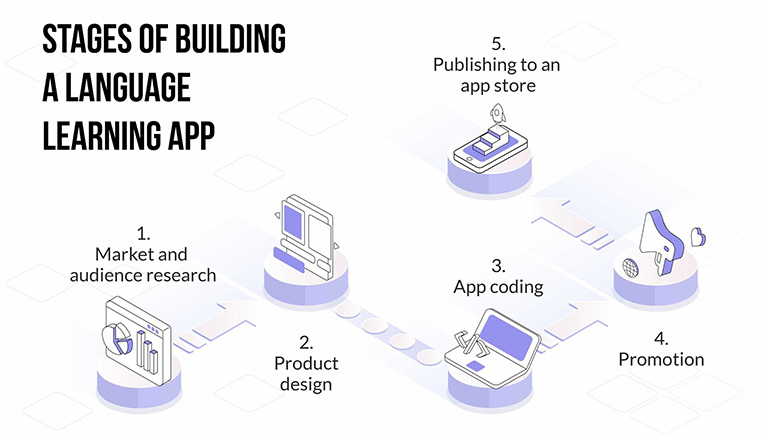What can you do when you don’t have an opportunity to travel? One method to satisfy your wanderlust is by immersing yourself in foreign language learning. The desire to speak foreign languages isn’t always about communication. In fact, sometimes, it is driven by the pleasure of learning. Babbel, a prominent language learning platform, revealed that 46% of its users are driven by pure enjoyment. Moreover, 35% engage in it as an intellectual exercise. But for those who are intrigued by this phenomenon and want to capitalize on it, the question arises: how to make a language learning app?
While Duolingo and Babbel are big names in the industry, there is a significant shortage of better and more effective language learning tools. Entering this field could not only fill this gap but also become a lucrative endeavor. Geniusee is here to guide those enthusiastic about carving a niche in this space, offering insights and expertise on creating an app that could compete with the titans. Dive in and get started on this linguistic journey!
How Do Language Learning Apps Like Duolingo Operate?
Understanding their functionality can be somewhat challenging for those who haven’t yet experienced language learning apps. Here are the most prevalent features incorporated into e-learning apps to enhance the effectiveness of studying:
Training Exercises
Language learning apps typically offer a range of exercises tailored to the language being studied, progressively increasing in complexity. Some of these exercises include:
- Matching foreign language words with their counterparts in the native language.
- Reading short passages and responding to comprehension questions.
- Listening to passages and answering questions or filling in missing words in sentences.
Video Content
The videos contain compelling visual cues that allow users to understand the content even when the language becomes difficult to comprehend. This makes video content a motivating tool for students, as it allows them to better understand real people speaking in a foreign language — an important milestone in language acquisition.
Books and Library Access
These resources contain essential theoretical knowledge, such as grammar and semantics, which are necessary for deeper language learning than simple vocabulary acquisition. While vocabulary acquisition is relatively straightforward, sentence construction requires an understanding of linguistic rules.
Chatbots
Chatbots serve as valuable additions to language learning apps, providing a supportive presence and encouraging users to persist in their learning journey. For instance, Duolingo employs advanced AI algorithms that can grasp user context and provide personalized responses. As a result, different users may receive distinct replies to the same query tailored to their individual preferences.
Key Stages to Develop a Language Learning App Similar to Duolingo
Let’s explore the steps involved in creating your own language-learning app. It’s important to note that developing such an app is a complex process that typically occurs in multiple stages.
Stage 1: Preparing to Build Your Language Learning App
Before you dive into app development, it’s crucial to conduct thorough research and identify the problems your app will address for your target audience.
- Market Research. Begin by researching the language learning market. In 2019, the online language learning market approached a value of $12.5 billion and is projected to double by 2027, thanks to a vast user base of approximately 1.6 billion global learners. Consider whether you will cater to individual users or institutions, as this decision will influence your app’s features and functionality.
- Target Audience. Determine your target audience, as this will determine the specific problems your app should solve. For example, an app for institutions might include a teacher’s administrative panel for customizing exercises, while a user-focused app could incorporate discussion sections for peer interaction. To identify target audience problems, conduct surveys and analyze your competitors.
Once you have gathered this data, you can proceed to design your app.
Stage 2: Designing Your App
A well-thought-out design is essential for attracting users and providing a seamless user experience. The design process can be broken down into micro-stages, including:
- Creating an eye-catching logo and selecting an engaging name.
- Conducting UI research and creating a UX map to define design elements like themes and color palettes.
- Developing app screens with meticulous attention to detail.
Stage 3: Development
This stage can be the most time-consuming, requiring up to 1,000 hours of work. It encompasses several phases, starting with iOS and Android development. Ideally, your app should be compatible with various devices. Some developers also opt for web development to make the app accessible from browsers. After development, thorough quality assurance (QA) testing is essential to eliminate bugs and ensure flawless performance before release.
Stage 4: Marketing and Sales
To ensure the success of your app, effective marketing, and promotion are vital. Use social media ads to reach potential users. Share captivating screenshots and videos highlighting your app’s strengths and differentiating features. Ideally, begin marketing alongside the later development phases to build an audience ahead of the app’s launch.
Stage 5: Publishing on App Stores
Publishing your app on platforms like Google Play and Apple App Store is relatively straightforward but involves a review process. App Store has strict guidelines, while Google Play is somewhat more lenient. Steps for publishing include:
- Signing up for a developer account.
- Ensuring your app meets quality guidelines.
- Conducting internal tests with up to 100 internal testers for feedback.
- Finally, publishing and promoting your app.
Embarking on developing a language learning app is a timely and promising endeavor, given the high demand for such applications. These apps provide an excellent workout for the mind, enhancing vocabulary and fostering various learning skills like pronunciation and translation, all while combating boredom.
However, it’s crucial to acknowledge that building a language-learning app requires a substantial investment of both time and money. For those seeking a successful and efficient solution, collaborating with experts capable of guiding you through every stage of custom app development is a wise choice.
The Geniusee team comprises tech enthusiasts who specialize in crafting customized web platforms and mobile applications of varying complexity. We offer comprehensive support, from gathering requirements and design to ongoing technical assistance. Choose a single team that will handle all aspects of your project with competence and expertise.




Leave a comment
Have something to say about this article? Add your comment and start the discussion.